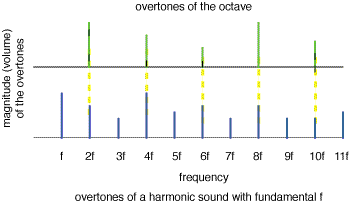

About the OctaveIn standard musical usage, the octave refers to two sounds whose fundamental frequencies are in a ratio of 2 to 1 often written in fractional form as 2/1. Such intervals are special because they tend to sound "the same" even though one is higher than the other. For instance, when an adult and a child sing together at the "same" note, they are really singing at an interval of an octave.One theory that tries to explain why we perceive octaves as similar begins with the observation that the sounds of most musical instruments have harmonic spectra. For example, a note with fundamental frequency equal to f Hz is shown in blue in the figure below: besides the fundamental, it has energy at twice the fundamental, three times the fundamental, four times the fundamental, etc. Real notes often have dozens of such overtones. Notes like this are said to have harmonic overtones, to have a harmonic spectrum, or to "be" harmonic. 
The octave of this note also has a harmonic spectrum. It is shown in green above. Observe that all of the overtones of the green note lie on top of (or at the same frequency as) one of the overtones of the blue tone. In essence, the top note (the octave) is contained in the lower note (the root). This is one explanation for why a tone and its octave blend together so as be perceived as "the same" even though they are obviously different. The TransformSynth also allows you to change the octave into the pseudo-octave. |
©2008 William Sethares; site design by Anthony Prechtl |